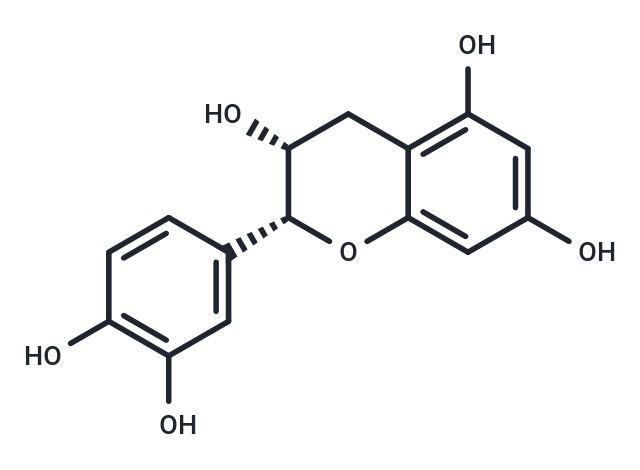Shopping Cart
- Remove All
 Your shopping cart is currently empty
Your shopping cart is currently empty

(-)-Epicatechin (Epicatechin) is an inhibitor of cyclooxygenase-1 (COX-1), inhibiting the IL-1β-induced expression of iNOS by blocking the nuclear localization of the p65 subunit of NF-κB.

| Pack Size | Price | Availability | Quantity |
|---|---|---|---|
| 10 mg | $53 | In Stock | |
| 25 mg | $67 | In Stock | |
| 50 mg | $86 | In Stock | |
| 100 mg | $120 | In Stock | |
| 1 mL x 10 mM (in DMSO) | $59 | In Stock |
| Description | (-)-Epicatechin (Epicatechin) is an inhibitor of cyclooxygenase-1 (COX-1), inhibiting the IL-1β-induced expression of iNOS by blocking the nuclear localization of the p65 subunit of NF-κB. |
| Targets&IC50 | COX-1:3.2 μM |
| In vitro | (-)-Epicatechin stimulates mitochondrial respiration and oxygen consumption in Panc-1 cells. Human normal fibroblasts are not affected. (-)-Epicatechin sensitizes Panc-1, U87, and MIA PaCa-2 cells with an average radiation enhancement factor (REF) of 1.7, 1.5, and 1.2, respectively. (-)-Epicatechin does not sensitize normal fibroblast cells to ionizing radiation with a REF of 0.9, suggesting cancer cell selectivity. (-)-Epicatechin enhances Chk2 phosphorylation and p21 induction when combined with radiation in cancer, but not normal cells[2]. |
| In vivo | Aging has deleterious effects on modulators of muscle growth/differentiation, the consumption of modest amounts of the flavanol (-)-Epicatechin can partially reverse these changes. In mice, myostatin and senescence-associated β-galactosidase levels increase with aging, while those of follistatin and Myf5 decrease. (-)-Epicatechin decreases myostatin and β-galactosidase and increases levels of markers of muscle growth. In humans, myostatin and β-galactosidase increase with aging while follistatin, MyoD and myogenin decrease. Treatment for 7 days with (-)-Epicatechin increases hand grip strength and the ratio of plasma follistatin/myostatin[1]. Low-dose (-)-Epicatechin treatment resulted in significant increases in skeletal muscle capillarity, mitochondrial biogenesis, and oxidative enzyme activity, which corresponded to lower muscle fatigue and higher endurance capacity when compared to the placebo group. (-)-Epicatechin may potentially regulate the protein expression between angiogenic and antiangiogenic factors, such as VEGF-A and TSP-1, respectively[3]. |
| Cell Research | Panc-1 cells are seeded into T-150 flasks and on the next day, cells are treated with different concentrations of (-)-epicatechin for 1 h, then harvested and solubilized in 10 mM HEPES (pH 7.4), 40 mM KCl, 1%Tween-20, 1 μM oligomycin, 1 mM PMSF,10 mM KF, 2 mM EGTA, and 1 mM Na3VO4. COX activity is measured in the presence of 20 mM ascorbate and 200 μM substrate cytochrome c from cow heart.(Only for Reference) |
| Alias | L-Epicatechin, Epicatechin, (-)-Epicatechol |
| Molecular Weight | 290.27 |
| Formula | C15H14O6 |
| Cas No. | 490-46-0 |
| Smiles | O[C@H]1[C@H](OC=2C(C1)=C(O)C=C(O)C2)C3=CC(O)=C(O)C=C3 |
| Relative Density. | 1.593g/cm3 |
| Storage | Powder: -20°C for 3 years | In solvent: -80°C for 1 year | Shipping with blue ice. | ||||||||||||||||||||||||||||||||||||||||
| Solubility Information | Ethanol: < 1 mg/mL (insoluble or slightly soluble) H2O: 2.25 mg/mL (7.75 mM), Sonication is recommended. DMSO: 45 mg/mL (155.03 mM), Sonication is recommended. | ||||||||||||||||||||||||||||||||||||||||
Solution Preparation Table | |||||||||||||||||||||||||||||||||||||||||
H2O/DMSO
DMSO
| |||||||||||||||||||||||||||||||||||||||||

Copyright © 2015-2025 TargetMol Chemicals Inc. All Rights Reserved.